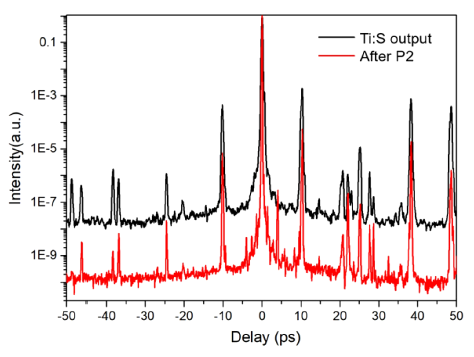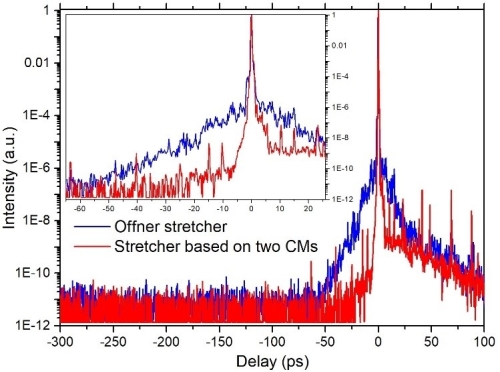Recently, researchers from Shanghai Institute of Optics and Fine Mechanics (SIOM) of the Chinese Academy of Sciences (CAS) have made new progress in the generation of high-contrast seed pulses and in the reducing temporal pedestal of an amplified pulse in an ultra-intense, ultra-short laser. The relevant results were published in Optics Letters on October 6,2021.
The contrast of a pulse is a critical parameter in an ultra-intense, ultra-short laser. Usually, besides the techniques after compression, one can obtain a high-contrast amplified pulse by using a high-contrast seed injection and controlling the noise in the amplification process.
About the seed pulses, researchers improve the contrast of the seed pulses by using the self-focusing effect in the thin solid plates (TSPs). In the TSPs, the main pulse of the focused laser experiences spatial periodical focusing and keep small size because of its high intensity, while the beam of the weak noise or satellite pulses diverges spatially because the low-level intensity could not trigger the self-focusing effect. Therefore, a pinhole can be used to block the noise and let the main pulse pass, and the temporal contrast of the pulse can be improved. Additionally, the spectrum of the pulses can be broadened because of the self-phase modulation effect in the TSPs. This simple device can improve the contrast and broaden the spectrum of the pulses simultaneously, which simplify the way to obtain a high-contrast, few-cycle pulse by a two-step method: firstly, improve the contrast by the pulse cleaning techniques; secondly, broaden the spectrum by the nonlinear compression techniques.
Researchers also designed a stretcher based on two concave mirrors, which avoided the far-field spectral phase noise and reduced the pedestal near the main pulse. In our single-shot PW laser, the pedestal noise was controlled at the level of 10-10 at the window of 10 ps before the main pulse (the energy of the amplified pulse is 1.7 J). This contrast is 4 orders of magnitude better than the Offner stretcher.
This work was supported by National Key R&D Program of China, Strategic Priority Research Program of the Chinese Academy of Sciences, National Natural Science Foundation of China, and Shanghai Municipal Science and Technology Major Project.

Fig. 1 Principle of contrast improvement in the TSPs. (Image by SIOM)

Fig. 2 Original contrast (black line) and improved contrast (red line). (Image by SIOM)

Fig. 3 Stretcher based on two concave mirrors with (a) top view and (b) side view. (Image by SIOM)

Fig. 4 Contrast measurements with the Offner stretcher (blue line) and the stretcher based on two concave mirrors (red line). (Image by SIOM)
Article website:
https://doi.org/10.1364/OL.440733
Contact:
WU Xiufeng
General Administrative Office
Shanghai Institute of Optics and Fine Mechanics, CAS
Email: xfwu@siom.ac.cn
Web: http://english.siom.cas.cn/